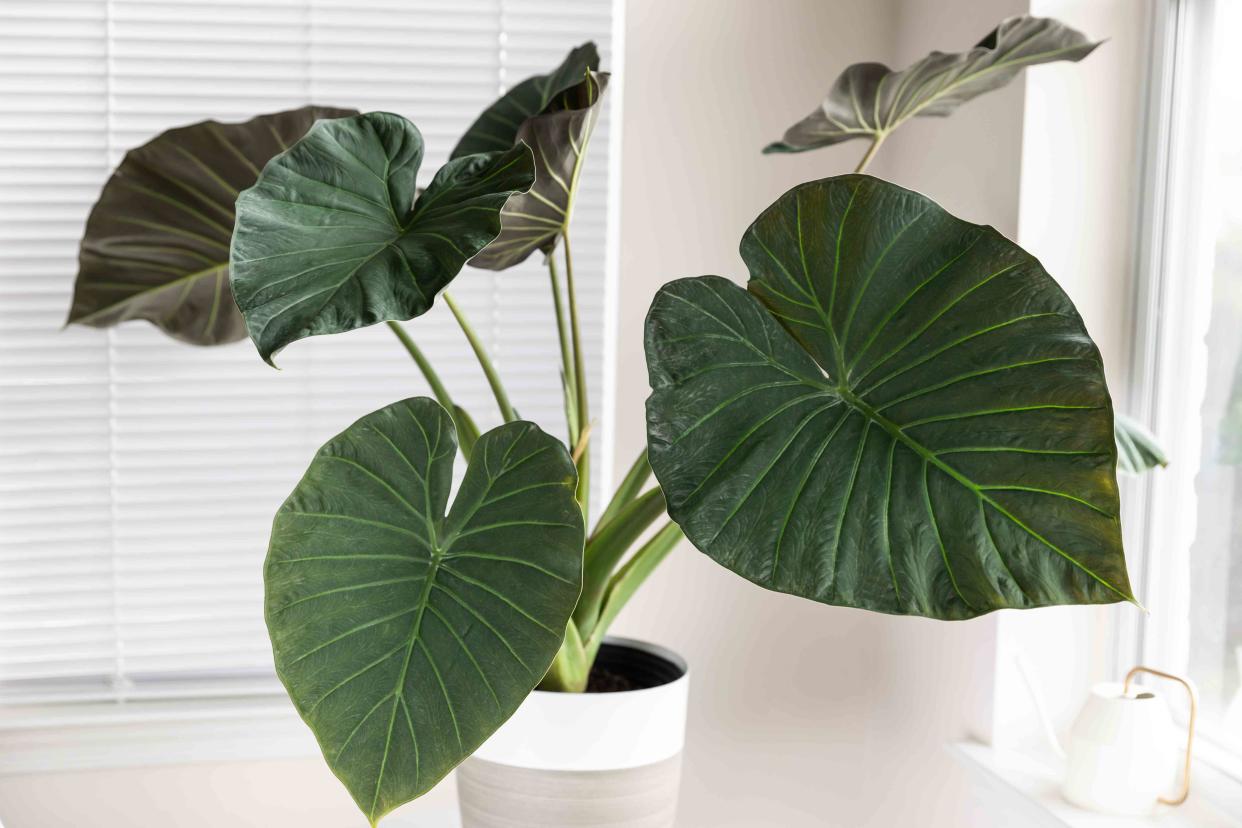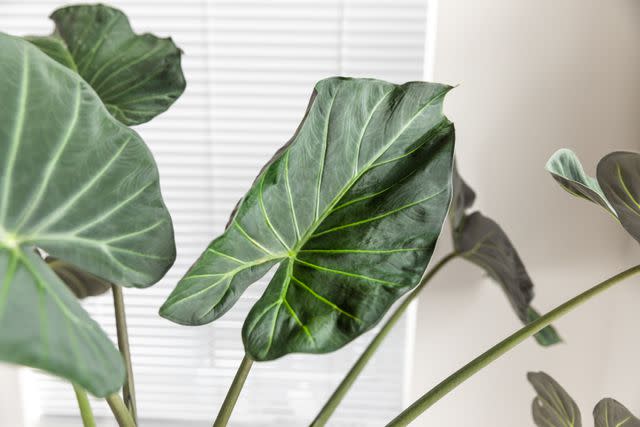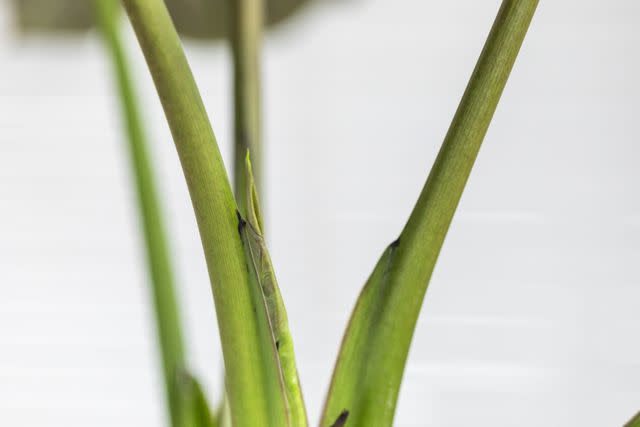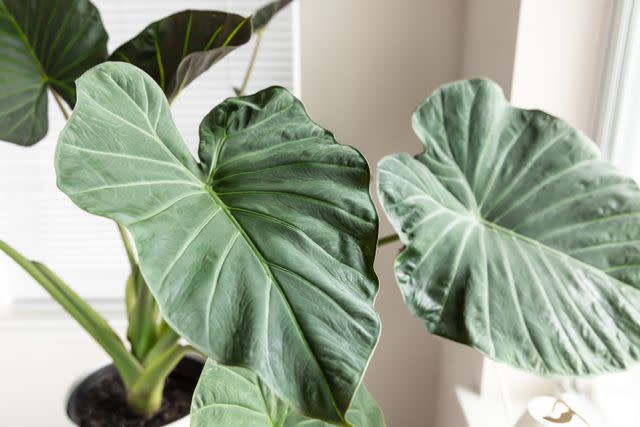How to Grow and Care for Alocasia ‘Regal Shield’ (Elephant Ear)

The Spruce / Anastasiia Tretiak
Reviewed by Kathleen Miller
Known for its large, sprawling leaves, Alocasia ‘Regal Shield’ is a stunning tropical evergreen perennial plant that can be grown both outdoors and indoors. A type of elephant ear plant, Alocasia can produce white or green flowers, albeit rarely. It thrives in partial sun and moist soil in a warm, humid atmosphere. Like other members of the Alocasia genus, all parts of these plants are toxic to both pets and people.
Common Name | Elephant Ear ‘Regal Shield’ |
Botanical Name | Alocasia |
Family | Araceae |
Plant Type | Perennial |
Mature Size | 4-5 ft. tall (indoors), 5-6 ft. tall (outdoors), 4-5 ft. wide |
Sun Exposure | Full, partial |
Soil Type | Loamy, moist but well-drained |
Soil pH | Acidic, neutral |
Bloom Time | Spring, summer |
Flower Color | White, green |
Hardiness Zones | 9-11 (USDA) |
Native Area | Africa |
Toxicity | Toxic to people, pets |
Alocasia Regal Shield Care
These plants can be a bit tricky to grow at times, but when given the right environment Alocasia 'Regal Shield' can be grown both indoors and outdoors. Here are the plant's main care requirements.
Plant in warm climates with plenty of humidity.
Place in partial or dappled sunlight, such as on a patio or near a bright window.
Use loamy soil that drains well and has a pH that is neutral or slightly acidic.
Keep an eye out for any spider-like webbing, as these plants are susceptible to spider mite infestations.

The Spruce / Anastasiia Tretiak

The Spruce / Anastasiia Tretiak

The Spruce / Anastasiia Tretiak
Light
When grown outside, Alocasia 'Regal Shield' will thrive in partial sun, or dappled light, such as on the edge of a covered patio or balcony. Morning sun is preferred, as afternoon sun can be intense and can cause scorched leaves.
When grown inside, these plants do best near the brightest window in your home, such as a south or north-facing window. This will provide them with the bright, indirect lighting they need. Be sure to rotate the pot a bit every week to ensure even growth, as the plant will inevitably turn towards the light.
Soil
The Alocasia 'Regal' Shield prefers light, loamy, slightly moist soil. It is vital that the soil is not too heavy since this can cause water retention and lead to root rot problems. Soil that is neutral to slightly acidic is preferred.
Water
Alocasia 'Regal Shield' enjoys moderate amounts of water and does best when the top few inches of the soil is allowed to dry out in-between watering. The frequency of watering will depend on the environment, how humid the area is, and how much sun the plant gets. Check the top few inches of soil with your finger, only providing more water if it feels dry.
Temperature and Humidity
As a tropical plant, Alocasia 'Regal Shield' thrives in warm, humid conditions. It enjoys high humidity levels and temperatures above 55 degrees Fahrenheit. When planted outdoors, it can be grown in zones 9 to 11.
For indoor plants, be sure to give them plenty of humidity through misting or humidifiers. Keep them away from harsh drafts, as this can dry out the plant.
Fertilizer
Alocasia 'Regal Shield' benefits from monthly fertilizing during the growing months. Use a well-balanced, light fertilizer to keep it healthy. Just be sure to use high-quality fertilizer, as cheaper fertilizers may contain high amounts of salt that can damage the plant. Alternatively, worm castings or fresh compost can be used to add nutrients to the soil in the spring. Be sure to stop fertilizing in the fall and winter as the plant goes dormant or slows in growth.
The 15 Best Places to Buy Plants Online in 2024
Pruning
Pruning this Alocasia plant will help direct nutrients to healthier leaves. Trim off any overgrown, damaged, or yellowing leaves as needed.
Propagating Alocasia Regal Shield
These plants are quite easy to propagate, since the parent plant reproduces by means of corms. To do this, you will need a small pot with moist, well-draining soil and a sharp, sterile knife. Then follow these instructions:
Prepare the small pot with well-draining, rich soil.
Using a sterile, sharp knife, cut the corm away from the mother plant. Cut right at the base and try to include some of the roots.
Gently plant the corm in its new pot and place it in an area that receives bright, indirect lighting.
Water the soil when it begins to feel dry and give the plant plenty of humidity. Roots should form in a couple of weeks.
Alternatively, you can try this Alocasia propagating technique:
Separate a corm from the parent plant.
Place the corm in a very shallow bowl of water (like a bottle cap). It should be partly submerged and partly exposed to the air.
Cover the corm with a bottle, bowl, or other glass dome to create a warm, humid environment.
Wait about 1 to 4 weeks until a root system and at least one leaf are visible before planting the new growth in soil.
How to Grow Alocasia Regal Shield From Seed
These large plants can also be started from seed, although the seedlings will take years before reaching their mature size. If you are looking for a fun project and don’t mind waiting for results, this is an option to consider.
To start elephant ears, you will need seeds, well-draining soil and peat moss, small pots or trays, and a misting bottle. Then follow these instructions:
Fill small pots or trays with moist, well-draining soil and peat moss.
Sprinkle the seeds onto the soil and lightly cover them.
Mist the soil, keeping it moist.
Be patient. Germination may take as long as three months.
Once signs of germination appear, move the seedlings to an area that receives bright, indirect lighting.
Keep the plants in an area with high humidity and bright light, repotting them as they grow.
Potting and Repotting Alocasia Regal Shield
Alocasia 'Regal Shield' grows wonderfully in containers, though it is important to note that these plants are quite top-heavy. Be sure to choose a pot that provides a sturdy base. These plants will need to be repotted every couple of years as the plant outgrows its current container size. When this occurs, simply choose a pot that is several inches larger than the current pot. Be sure it has good drainage holes to allow access water to drain away. Gently tip the plant on its side and tap around the circumference of the pot in order to loosen the roots. Then, slide the plant out and place it in the larger pot with fresh potting soil.
Overwintering
If this plant is kept indoors, be sure to place it near a bright window during the winter months to ensure it receives enough light. The plant may go dormant, and you will not need to water as much as in the summer months. Withhold any fertilizer.
Elephant ear plants should not be kept outside if temperatures dip below 55 degrees Fahrenheit. If this is the case, be sure to bring this plant indoors.
Common Pests
Alocasia plants are vulnerable to spider mites. To avoid this, make sure the plant is not getting too dry. Spider mites feed on the plant's sap, which can turn the foliage yellow or brown. They can also cause red bumps to form on the plant due to a toxin they inject while feeding. The presence of webbing on the foliage is a common sign of spider mite infestation.
How to Get Alocasia 'Regal Shield' to Bloom
Most people are unaware that these plants do, in fact, produce flowers since it is a rare occurrence.
Bloom Months
If you're lucky enough to have a plant that produces blooms, it will typically occur in the spring and summer months.
How Long Does Alocasia 'Regal Shield' Bloom?
Keep in mind that blooming only happens once the plant is fully mature and if perfectly ideal conditions exist. Individual blooms can last two to three weeks.
What Do Alocasia 'Regal Shield' Flowers Look and Smell LIke?
The flowers of Alocasia 'Regal Shield' appear on tall stalks and look very similar to peace lilies. They are white to green in color and are not overly showy.
How to Encourage More Blooms
Even in ideal conditions, the Alocasia 'Regal Shield' may not flower. To encourage it to bloom, be sure it receives plenty of humidity and stable temperatures. Water when the soil begins to dry, and give fertilizer monthly during the growing season. With time and patience, your elephant ear may surprise you with a flower.
Caring for Alocasia 'Regal Shield' After it Blooms
Once your plant finishes blooming, it will go dormant. At this point, you should water it sparingly and stop fertilizing.
Deadheading Alocasia 'Regal Shield' Flowers
You can remove spent blooms to make room for new ones. Use sterilized gardening shears or scissors.
Common Problems With Alocasia 'Regal Shield'
Alocasia Regal Shield can be a bit picky at times, and will communicate that it is unhappy with its current growing conditions. Here are some common problems encountered when growing this plant and how you can address them.
Yellowing, Wilting Leaves
This is often a sign of overwatering. If the problem is not remedied, this can lead to root rot. To fix this, replace the soil with a better draining soil mixture and cut back on watering. The plant should perk up in a week or so.
Yellowing Leaves with Webs
This is most likely a spider-mite infestation. Trim away any infected leaves and dispose of them to avoid further contamination. Spray the plant with neem oil or other insecticidal solution.
Dry Brown Spots or Edges
This is a sign of too little humidity or water. Check the soil with your finger to determine whether or not the plant needs water. Try adding a humidifier nearby or start misting the leaves to give the plant more humidity.
Frequently Asked Questions
How fast does Alocasia 'Regal Shield' grow?
These large plants are relatively fast growers and can reach their full height in a few years. If you have purchased a very small plant or have started it from seed, it will take many years before the plant reaches its full height of 6 feet.
Should you mist Alocasia 'Regal Shield'?
Alocasia 'Regal Shield' requires high humidity levels to thrive. Misting is a fun and easy way to give this plant the humidity it needs. If misting does not prove to be enough, try placing a humidifier near the plant.
Can Alocasia 'Regal Shield' be grown indoors?
These popular tropical plants can be grown both outdoors and indoors and can be a houseplant star with their oversized leaves. Because they can reach up to 6 feet tall, it is important to give them plenty of space when keeping them indoors.
Read the original article on The Spruce.

